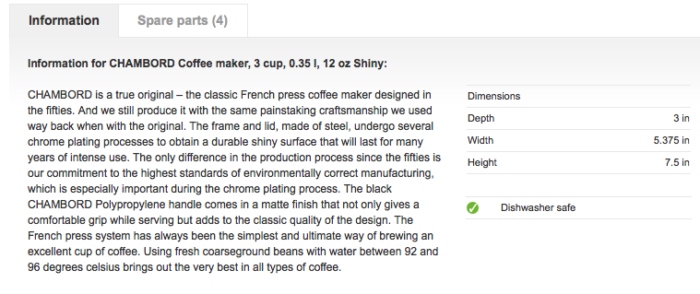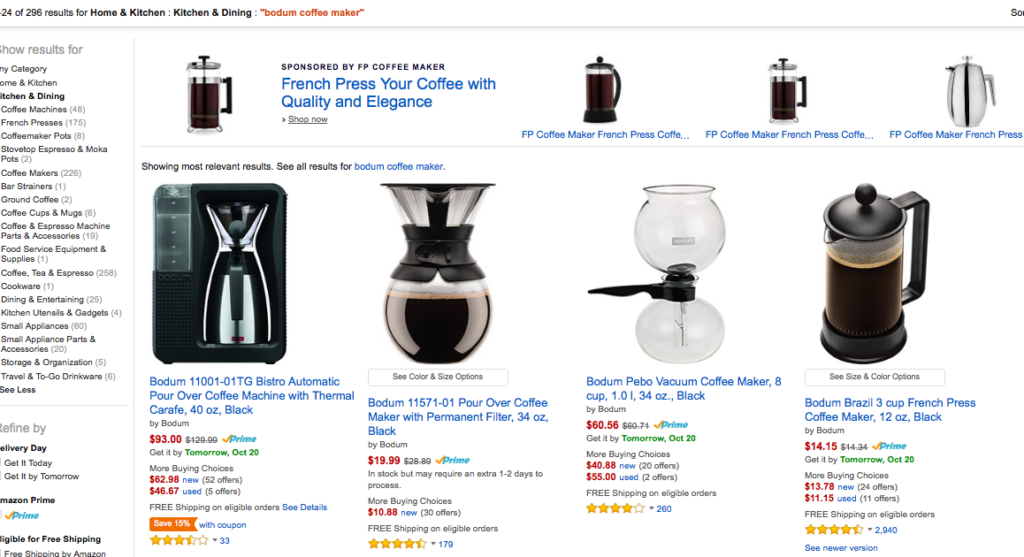Product Content Is Key To Competing With Amazon
As the 2016 holiday season approaches, the usual hype and headlines about how massive Amazon is are surely causing the usual heightened anxiety amongst its competitors. In a post a few months ago looking at the latest online retail stats for the U.S., I noted how retailers, especially those with physical stores that have roots in the pre-online era, have a hard time seeing how they can effectively compete with Amazon. Too many retailers look at the online behemoth’s masterful pricing, logistics and fulfillment operations, and at how it has been able to grow without having to demonstrate profitability to investors, and feel like the odds are stacked against them.
For commodity products or for those where customers already have a preferred brand in mind, customers are primarily driven by price and convenience, since they have a choice of where to get the same identical item. Those shoppers, who already know what they want and the price they want to pay, will find it easiest to go to Amazon. This is why apparel retailers, for one, are struggling: how do you attract a customer to your site for a pair of name brand sneakers if Amazon offers the largest assortment in colors, size, and prices and will deliver within the day?
How Amazon stinks at product content
There is one area where retailers can focus in which Amazon is absolutely terrible: product content. For products where online shoppers are looking for in-depth information, advice, and help narrowing their choices – the types of services that they would rely on a good sales associate to perform in a physical store – product content plays a major role in the online environment.
Say you are in a physical store and you are looking for help in which type of coffee maker to buy: does the sales associate come up to you and start spouting details about each coffee maker’s technical specs and the colors and sizes they come in? Probably not, but that’s the type of detail the manufacturer typical provides for product descriptions. Rather, a good sales associate will first ask you a few questions to find out more about what you are looking for, such as what type of coffee you like to make and where you will be using it, at home or at work? The sales associate can then deduce from your answers which models to recommend from additional conversation, narrow down your selection further. You provide the context to the sales person, and they in turn guide you to a purchase where you feel like you’ve made an informed decision.
Currently, Amazon is like that sales associate spouting lots of manufacturer-provided details that may have little to do with what you are looking for. For those purchases where customers are looking for well-informed guidance online, product content combined with customer data (i.e. search terms used, if they have purchased in the past, where they are geographically) can help fill in the role that a good sales associate would play in a physical store. A video, for example, can show how to brew different strengths of coffee and how to clean the machine. Product reviews (ok, fine, Amazon is good with the product reviews) can provide validation or criticism from previous buyers of a particular model. Different views of the machine from different angles, rather than just a flat image, shows a 360 degree view to give a better sense of the space it will require and its overall shape. And if it is a machine that sells in many different countries, it will provide the content in local languages and tailored to local contexts.
Here’s an example of great product content. Bodum, a manufacturer of coffee and tea makers, provides in-depth visual details of a particular coffee when the viewer moves the mouse over the photo image, including the color and size selected:

This visual is accompanied by a text description that details how the coffee maker is made, what materials go into it, and the best type of coffee beans to brew in it:
To see the product content on Amazon for the same model in the images above involves weeding through hundreds of results for different models and price points:

If you are looking for a coffee-maker purely by price and don’t care about brand or model, Amazon is clearly the right choice from the two examples above. But if you want guidance, information, and navigation through the hundreds of choices available for a premium product like Bodum, Amazon will not get you there the way the brand or a retailer that has provided online real estate for the brand content will.
The many paths to great product content
The types of product content investment an online retailers will need to make will vary widely by its existing in-house capabilities and technology infrastructure, target customer segments, number of SKUs, and growth plans. For some, upgrading to a new version of an existing CMS may be sufficient; others may need to consider a product information management (PIM) solution. For advice services to determine what technologies to consider for improved product content, contact us. And for more information about context and relevance, see our recent report Preparing for the Holiday Retail Season: The Amazon Threat and the Facebook Trap (registration required).








